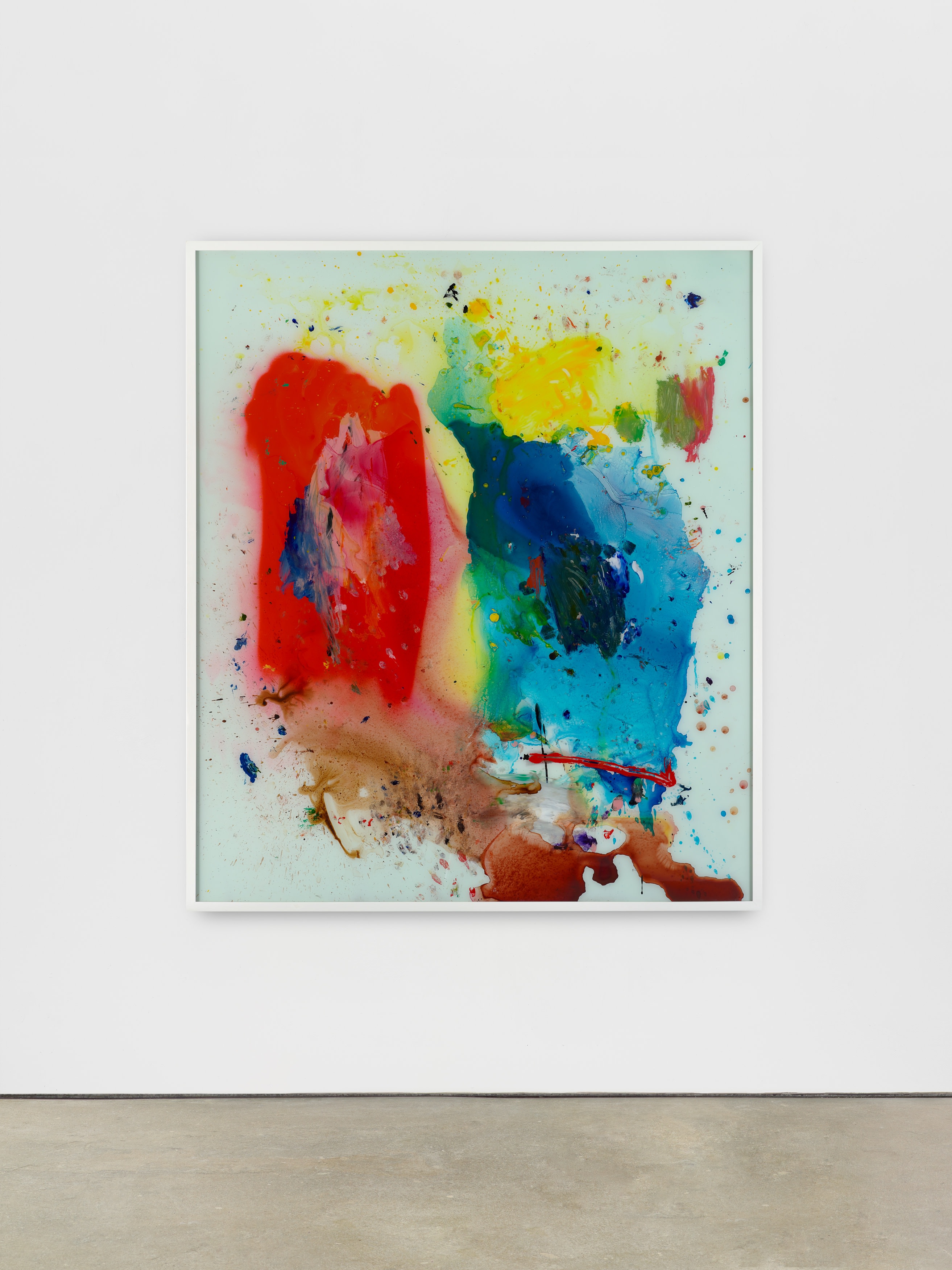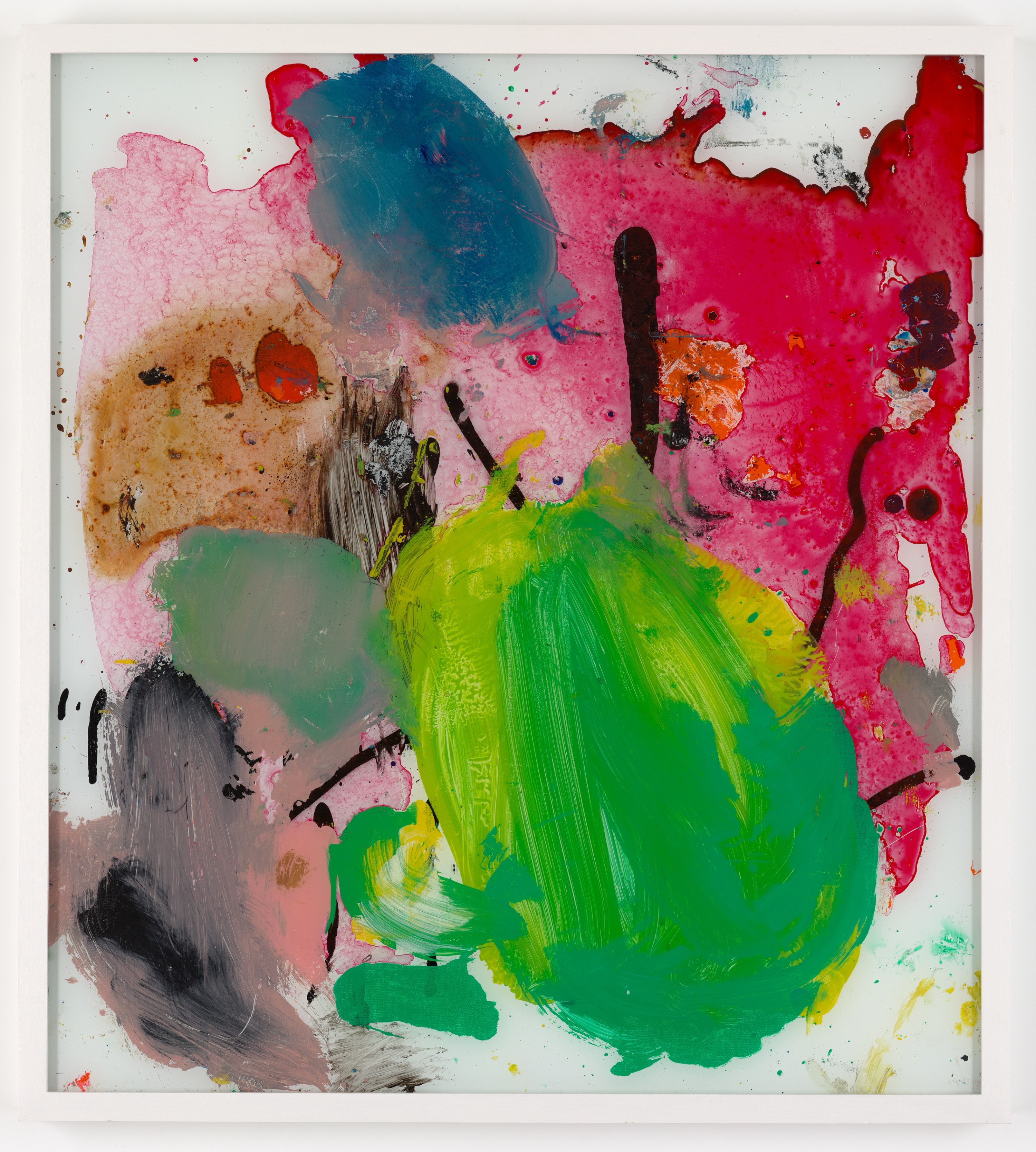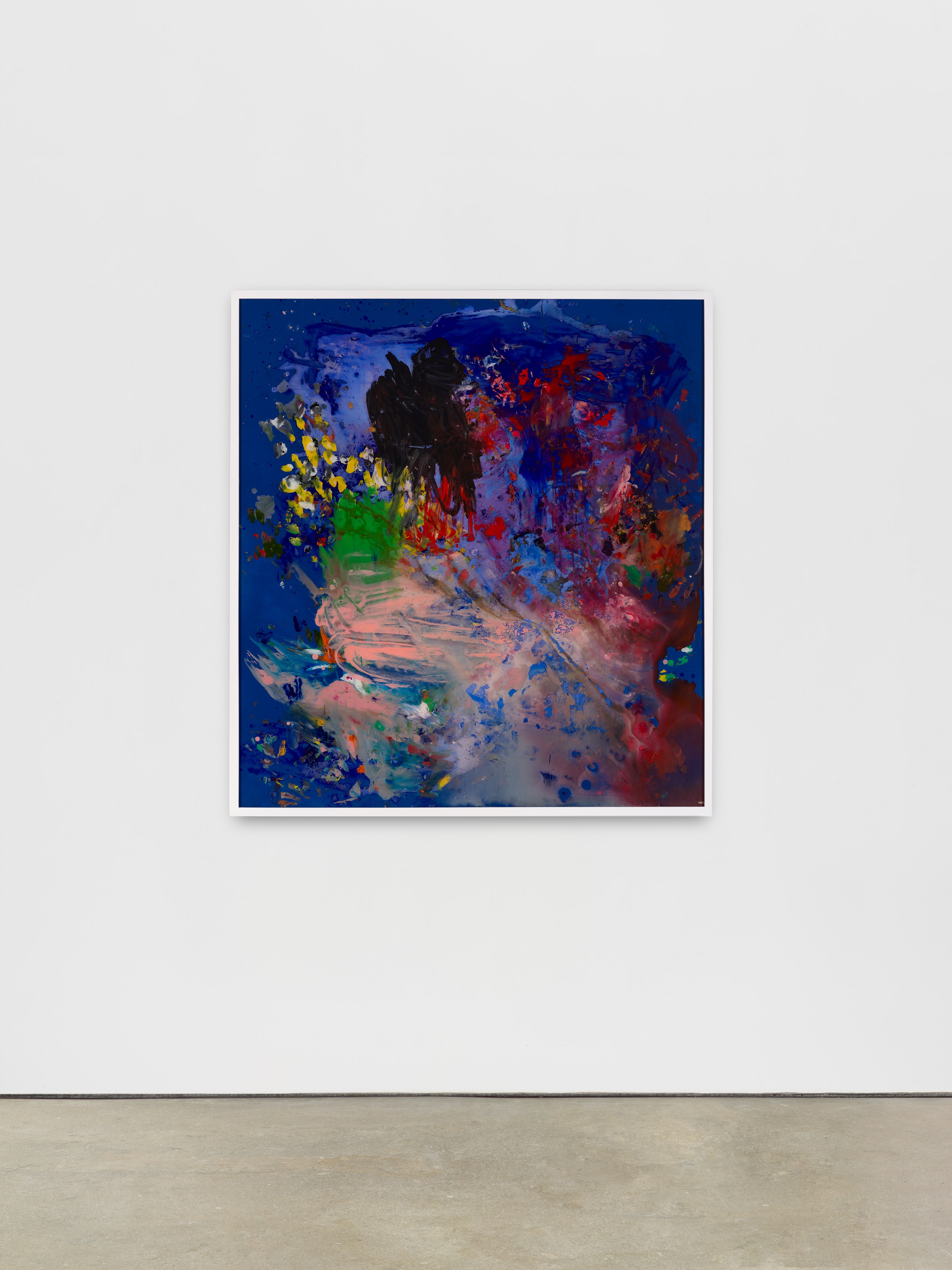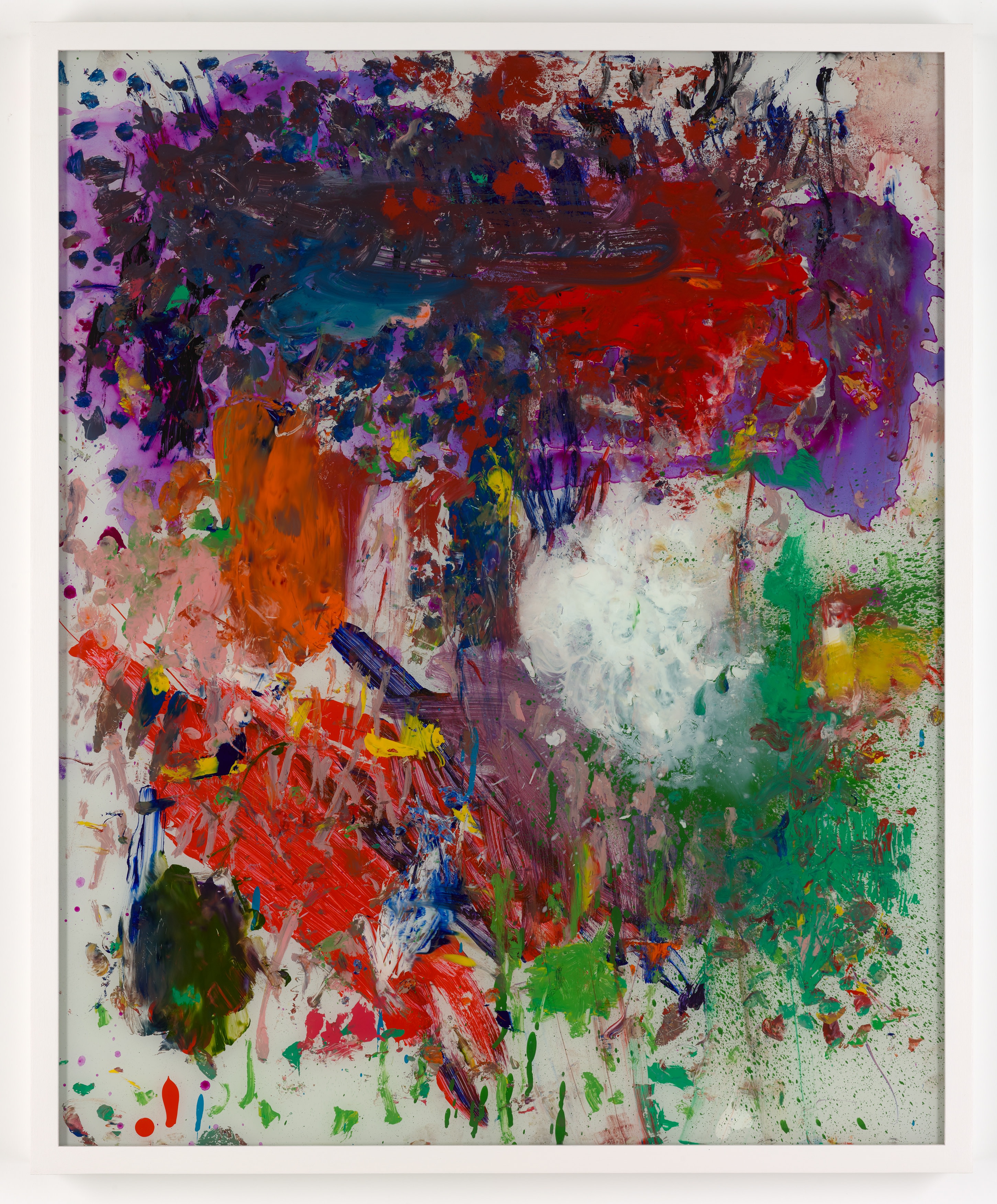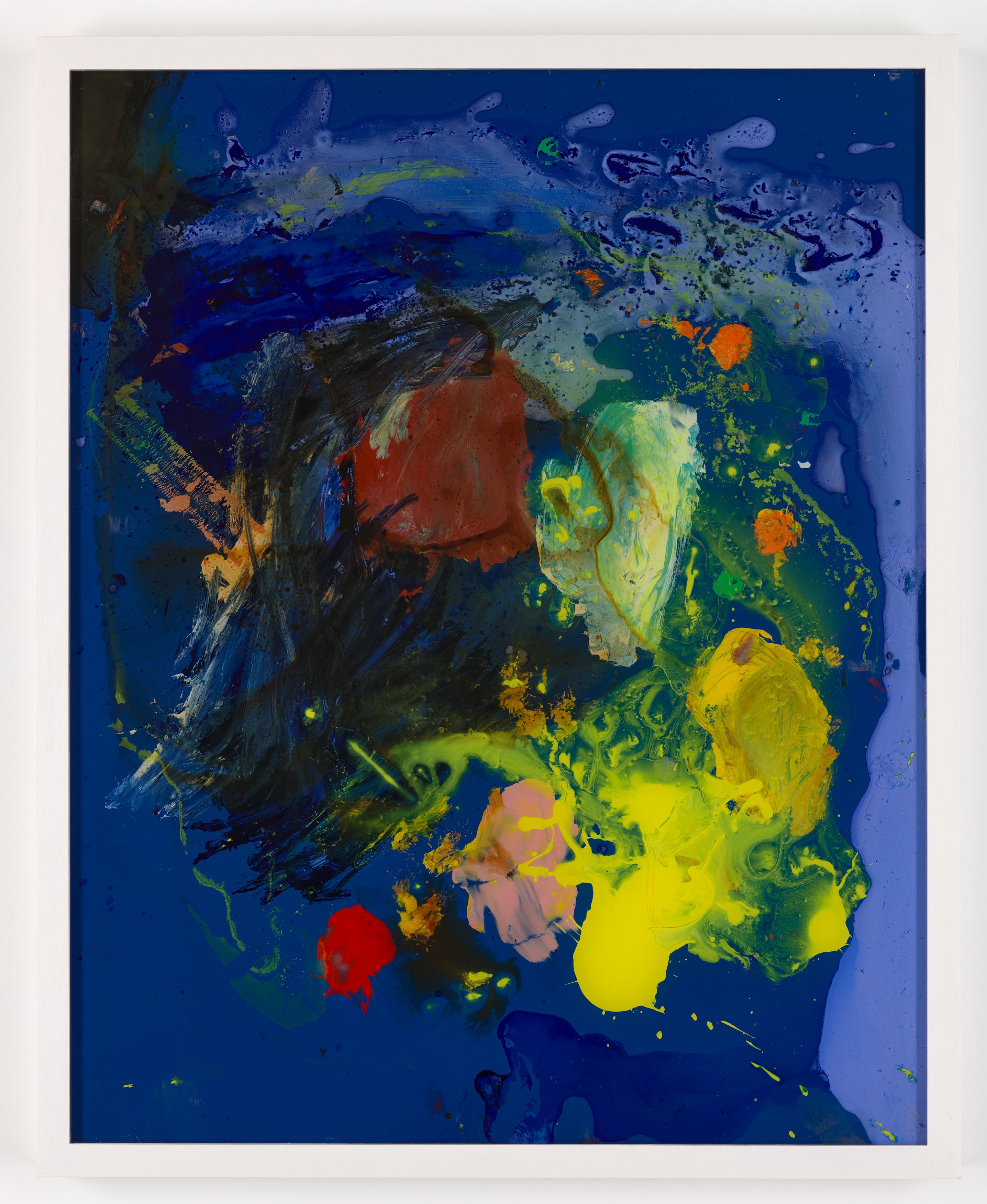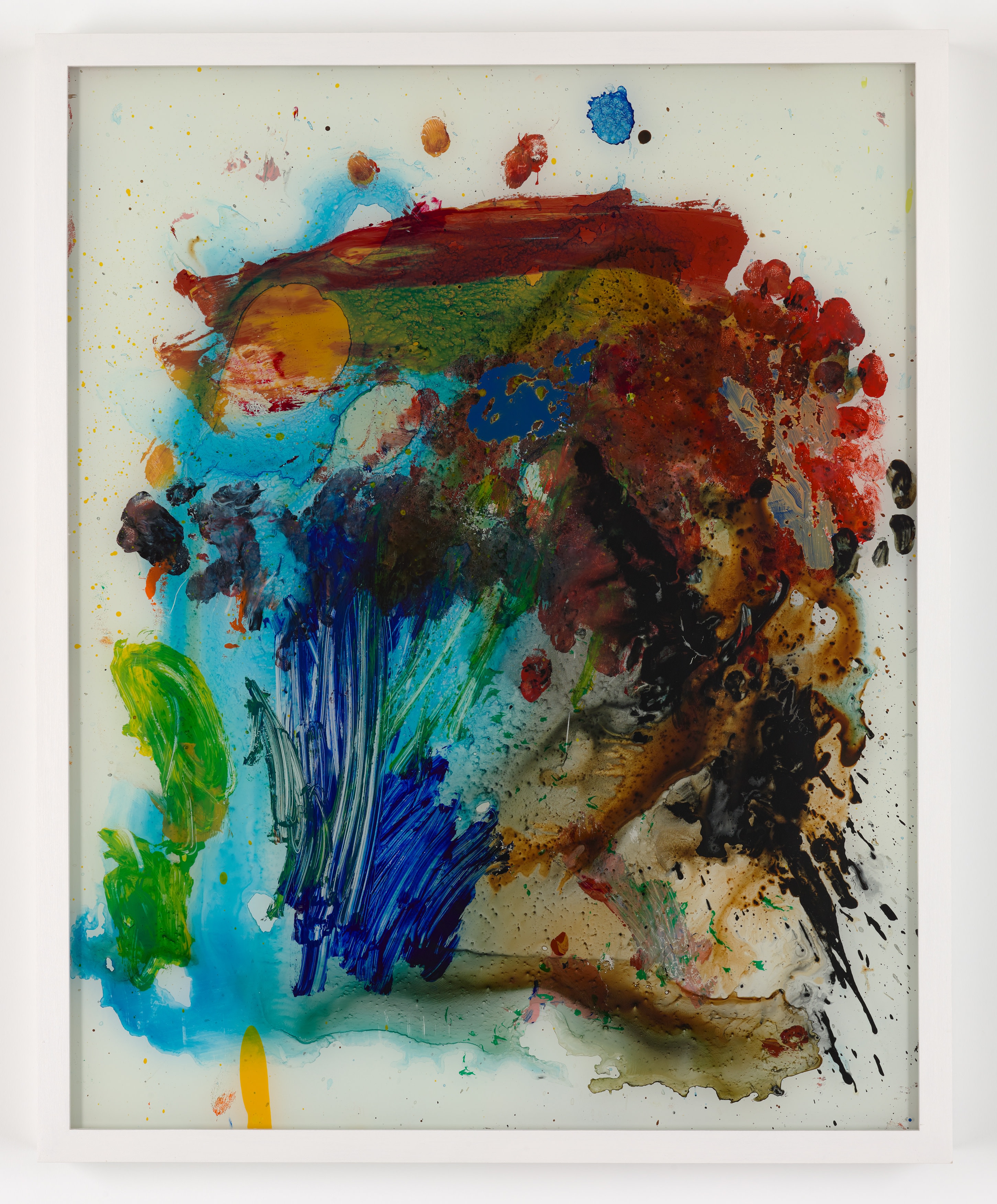-
 Portraits by James Frederick Barrett
Portraits by James Frederick Barrett -
 Polyester Angel, 2021oil, ink and spray paint on glass143 × 123 cm (56 ¼ × 48 ½ in)(TG187)
Polyester Angel, 2021oil, ink and spray paint on glass143 × 123 cm (56 ¼ × 48 ½ in)(TG187) -

-
TIM GARWOOD IN CONVERSATION WITH SIM SMITH
SIM SMITH: I've always known your studio to be full of activity and full of very varied works in progress; large canvases on the floor picking up debris, panes of glass leaning against the walls half covered in paint, pieces of assemblage coming together on top of cabinets and hanging from shelves. Your work has always come about through this pace, one thing leading to the next and working on multiple things at once. What draws you to your materials?
TIM GARWOOD: I actually find it hard to not view things as a material that I could use in a work. I always have an internal battle, trying to keep some sort of focus on what to make. Maybe that's a bad thing, I don't know, but I've got a feeling that if I don't keep some sort of leash on what I'm doing it could all become too unwieldy and sprawling. Occasionally I think I've gone down a bit of a rabbit hole while making things, but they always end up being useful as ways to help me think about new works later on. I'm the sort of person who always thinks 'that'll come in handy one day' whether it's because of something's colour, or the way that it's rusting - that sort of thing. There's always been endless materials on the streets around my studio.
Now that I'm a bit older I've also realised that some things can be made in my head as a way of learning from them - they don't need to exist as objects.
-
 Superior Angel, 2021oil, ink and spray paint on glass113 × 93 cm (44 ½ × 36 ½ in)(TG195)
Superior Angel, 2021oil, ink and spray paint on glass113 × 93 cm (44 ½ × 36 ½ in)(TG195) -

-
-
SS: What made you focus on painting on glass again after working on canvas for the last few years?
TG: Glass and canvas are opposites. Making paintings on them is totally opposite. On glass I'm working back to front - working on the reverse of the glass means painting the 'foreground' first, then building on top of it until the glass is covered. Glass is invisible, and it allows for paint to look 'wet' in a way you could never capture on canvas. It can capture a gesture or moment in a unique way.
I'm the kind of person who likes extremes, in everything - music, food, people, surroundings, all sorts of things. I don't enjoy existing in a middle space. That's the same in my painting. Glass and canvas are extremely different supports. The way that you treat them is different and their properties are different. What you can do to them is completely different. It's stimulating to swap between the two and keeps it interesting. I enjoy being tripped up by paintings. Working on glass I am always having to flip the pane to check it is doing what I expected. Even after all this time, I still sometimes do things back to front - it's like when people try writing back to front, they often end up doing a "N" with the line in the middle going the wrong way.
-
 Fracas (blue), 2021oil, ink and spray paint on glass143 × 123 cm (56 ¼ × 48 ½ in)(TG188)
Fracas (blue), 2021oil, ink and spray paint on glass143 × 123 cm (56 ¼ × 48 ½ in)(TG188) -
SS: The quality of the paintings on glass doesn't feel like anything else, I'm not sure if it's the medium or the way in which you make them that does it. Can you talk a bit more about that?
TG: Reverse painting on glass transforms the painterly decision-making process, inverting the order of what is seen, opening up a unique spatial quality. In some ways there is an illusion of immediacy that I am playing with. Because I'm working back to front, I have to pre-empt things in a different way to working on a traditional support like canvas. It's no good getting to the end of a painting and then thinking 'ah what this needs is a splash of red" or whatever - it's too late; the glass is covered, it's finished.
Once painted the surface of the glass becomes very seductive. There is something enjoyable in the very messy application of paint on such a perfect surface. Something in your brain is telling you that you are experiencing textured paint but you also know that there is no texture at all. I like that. I like the idea that people don't really know what they are looking at. They know it is a painting because they are told it is a painting but it doesn't have some of the properties that we expect of a painting. They have some sort of cross over into a digital, screen-like surface, whilst still being so painterly.
-

-
 Mouse Versus Spider, 2021oil, ink and spray paint on glass57 × 51.5 cm (22 ½ × 20 ¼ in)(TG199)
Mouse Versus Spider, 2021oil, ink and spray paint on glass57 × 51.5 cm (22 ½ × 20 ¼ in)(TG199) -

-
 Voice Processor, 2021oil, ink and spray paint on glass123 × 113 cm (48 ½ × 44 ½ in)(TG193)
Voice Processor, 2021oil, ink and spray paint on glass123 × 113 cm (48 ½ × 44 ½ in)(TG193) -
SS: There are marks that you seem to make again and again in the paintings. They feel truthful and instantaneous but also seem to oscillate between suggestions of place, the corporeal and association. Can you tell me more about the marks that you use?
TG: In these paintings I started with completely random, incidental, mark-making, quick and not overly thought through. Every colour I had in oil. Fast and energetic, almost frantic. This goes back to what I was saying about an illusion of spontaneity - if I was working on canvas then I would lay the sheet of canvas on the floor - walk on it, spill things on it and it would naturally build up an interesting surface before I then stretch it and begin to work on it in a more focused way. With glass I can't do that - walk on it or disregard it in the same way. Everything has to be more intentional. It's a great bounce between working with canvas and then glass. The finished paintings have similar energy but the process to arrive there is totally different.
I painted large sections of these works with my hands. There's something about the instinctive and tactile marks of fingers that is very powerful, it feels primal.
-
 Parliament, 2021oil, ink and spray paint on glass83 × 68 cm (32 ½ × 26 ½ in)(TG198)
Parliament, 2021oil, ink and spray paint on glass83 × 68 cm (32 ½ × 26 ½ in)(TG198) -
-

-
SS: You seem to be in a period where you know what you're meant to be doing. Do you feel that too?
TG: Yes these works are right for me at the moment. As always though I'm starting to think, hmm maybe now's a good time to make some prints or experiment with something new. It feels good that so many of these pieces came together at the same time. It solidified a new way of making the works for me and now I can revisit it at any time.
-
 Wired, 2021oil, ink and spray paint on glass83 × 68 cm (32 ½ × 26 ½ in)(TG197)
Wired, 2021oil, ink and spray paint on glass83 × 68 cm (32 ½ × 26 ½ in)(TG197) -
-
SS: You're based between London and Somerset and make work in both places. That must shape your visual perceptions in different ways. How do you feel these places influence your work, is the work you make different in each place?
TG: I have no idea! I'm sure I could say something predictable about pace of life in the city versus the speed in the countryside but I'm not really conscious of that sort of thing. I just feel that I go through life with my eyes open. Looking at things and wondering what their potential could be to make art. I then filter that a bit, simply because there isn't enough time in the world to explore every idea and I think some sort of deeper investigation is probably better than a scattergun approach. But I may be wrong, there are definitely some ideas I've had that I wish I had pushed further.
SS: Like what?
TG: Assemblage pieces mainly.
SS: Can't you make them now?
TG: Not those works. If an idea sits for too long without being made then it goes stale. I think my work is best when it shows spontaneity - even if that spontaneity is calculated. With assemblage works I think if too much time is left to make them then they become too refined and neat. They need a to-hand roughness.
-
 JOOP!, 2021oil, ink and spray paint on glass62 × 50 cm (24 ½ × 19 ¾ in)(TG201)
JOOP!, 2021oil, ink and spray paint on glass62 × 50 cm (24 ½ × 19 ¾ in)(TG201) -
 A Beetle, 2021oil, ink and spray paint on glass55 × 49 cm (21 ¾ × 19 ¼ in)(TG200)
A Beetle, 2021oil, ink and spray paint on glass55 × 49 cm (21 ¾ × 19 ¼ in)(TG200) -
 BUD, 2021oil, ink and spray paint on glass52 × 42 cm (20 ½ × 16 ½ in)(TG202)
BUD, 2021oil, ink and spray paint on glass52 × 42 cm (20 ½ × 16 ½ in)(TG202) -
SS: Do the paintings need to feel a certain way in order for them to work for you? Do they reference anything in particular?
TG: They do need to feel a certain way but that certain way can be a hundred different ways. I just know when it is right and when it isn't. Mostly paintings don't reference anything in particular but I do like to give them specific titles that allude to something like an object or an animal or something. I think offering opportunities to think about something else is half the job of a painting. One recent painting is called A Beetle - think about finding a stag beetle as a child for a moment. That sort of thing is a good use of your time.
SS: What is your working day like? Is there anything that influences the work, like listening to music or anything else?
TG: I can't work in silence. It feels too serious. I tend to get obsessed with a certain album that I listen to over and over again for a month or so before falling into another one.
SS: Which albums recently?
TG: It doesn't really matter; the music is so varied that I think if I gave you a specific record then it would give the impression that there is always the same attitude in the studio but realistically the music is there to cut through the focus a bit. In the same way as having a beer in an evening and then painting offers more freedom. It's so important to not be precious when painting. OK, there reaches a time when, yes, it's 'done' and needs to be protected - from me(!) - but the painting has to absorb a feeling of not really giving a fuck in order to be able to survive its life in the real world.
SS: To me your work is full of intuition and spontaneity and is imbued with the re-imagination of materials and the idea of potential and that is what makes it so powerful and distinctive. I know the work is rooted in the exploration of painting itself, but the paintings are also so potent on a very primal level; they are atmospheric and romantic, chaotic and beautiful but resist easy categorisation. Let's finish on that?
TG: Sure, lets finish on that.
-
 Flea, 2021oil, ink and spray paint on glass52 × 42 cm (20 ½ × 16 ½ in)(TG203)
Flea, 2021oil, ink and spray paint on glass52 × 42 cm (20 ½ × 16 ½ in)(TG203)
TIM GARWOOD — New paintings
Past viewing_room

